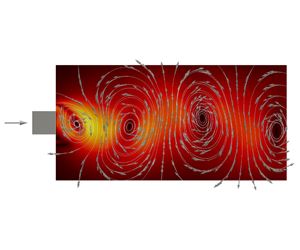Published online by Cambridge University Press: 01 June 2020

We use direct numerical simulation data to study interscale and interspace energy exchanges in the near field of a turbulent wake of a square prism in terms of a Kármán–Howarth–Monin–Hill (KHMH) equation written for a triple decomposition of the velocity field which takes into account the presence of quasi-periodic vortex shedding coherent structures. Concentrating attention on the plane of the mean flow and on the geometric centreline, we calculate orientation averages of every term in the KHMH equation. The near field considered here ranges between two and eight times the width  $d$ of the square prism and is very inhomogeneous and out of equilibrium so that non-stationarity and inhomogeneity contributions to the KHMH balance are dominant. The mean flow produces kinetic energy which feeds the vortex shedding coherent structures. In turn, these coherent structures transfer their energy to the stochastic turbulent fluctuations over all length scales
$d$ of the square prism and is very inhomogeneous and out of equilibrium so that non-stationarity and inhomogeneity contributions to the KHMH balance are dominant. The mean flow produces kinetic energy which feeds the vortex shedding coherent structures. In turn, these coherent structures transfer their energy to the stochastic turbulent fluctuations over all length scales  $r$ from the Taylor length
$r$ from the Taylor length  $\unicode[STIX]{x1D706}$ to
$\unicode[STIX]{x1D706}$ to  $d$ and dominate spatial turbulent transport of small-scale two-point stochastic turbulent fluctuations. The orientation-averaged nonlinear interscale transfer rate
$d$ and dominate spatial turbulent transport of small-scale two-point stochastic turbulent fluctuations. The orientation-averaged nonlinear interscale transfer rate  $\unicode[STIX]{x1D6F1}^{a}$ which was found to be approximately independent of
$\unicode[STIX]{x1D6F1}^{a}$ which was found to be approximately independent of  $r$ by Alves Portela et al. (J. Fluid Mech., vol. 825, 2017, pp. 315–352) in the range
$r$ by Alves Portela et al. (J. Fluid Mech., vol. 825, 2017, pp. 315–352) in the range  $\unicode[STIX]{x1D706}\leqslant r\leqslant 0.3d$ at a distance
$\unicode[STIX]{x1D706}\leqslant r\leqslant 0.3d$ at a distance  $x_{1}=2d$ from the square prism requires an interscale transfer contribution of coherent structures for this approximate constancy. However, the near constancy of
$x_{1}=2d$ from the square prism requires an interscale transfer contribution of coherent structures for this approximate constancy. However, the near constancy of  $\unicode[STIX]{x1D6F1}^{a}$ in the range
$\unicode[STIX]{x1D6F1}^{a}$ in the range  $\unicode[STIX]{x1D706}\leqslant r\leqslant d$ at
$\unicode[STIX]{x1D706}\leqslant r\leqslant d$ at  $x_{1}=8d$ which was also found by Alves Portela et al. (2017) is mostly attributable to stochastic fluctuations. Even so, the proximity of
$x_{1}=8d$ which was also found by Alves Portela et al. (2017) is mostly attributable to stochastic fluctuations. Even so, the proximity of  $-\unicode[STIX]{x1D6F1}^{a}$ to the turbulence dissipation rate
$-\unicode[STIX]{x1D6F1}^{a}$ to the turbulence dissipation rate  $\unicode[STIX]{x1D700}$ in the range
$\unicode[STIX]{x1D700}$ in the range  $\unicode[STIX]{x1D706}\leqslant r\leqslant d$ at
$\unicode[STIX]{x1D706}\leqslant r\leqslant d$ at  $x_{1}=8d$ does require interscale transfer contributions of the coherent structures. Spatial inhomogeneity also makes a direct and distinct contribution to
$x_{1}=8d$ does require interscale transfer contributions of the coherent structures. Spatial inhomogeneity also makes a direct and distinct contribution to  $\unicode[STIX]{x1D6F1}^{a}$, and the constancy of
$\unicode[STIX]{x1D6F1}^{a}$, and the constancy of  $-\unicode[STIX]{x1D6F1}^{a}/\unicode[STIX]{x1D700}$ close to
$-\unicode[STIX]{x1D6F1}^{a}/\unicode[STIX]{x1D700}$ close to  $1$ would not have been possible without it either in this near-field flow. Finally, the pressure-velocity term is also an important contributor to the KHMH balance in this near field, particularly at scales
$1$ would not have been possible without it either in this near-field flow. Finally, the pressure-velocity term is also an important contributor to the KHMH balance in this near field, particularly at scales  $r$ larger than approximately
$r$ larger than approximately  $0.4d$, and appears to correlate with the purely stochastic nonlinear interscale transfer rate when the orientation average is lifted.
$0.4d$, and appears to correlate with the purely stochastic nonlinear interscale transfer rate when the orientation average is lifted.